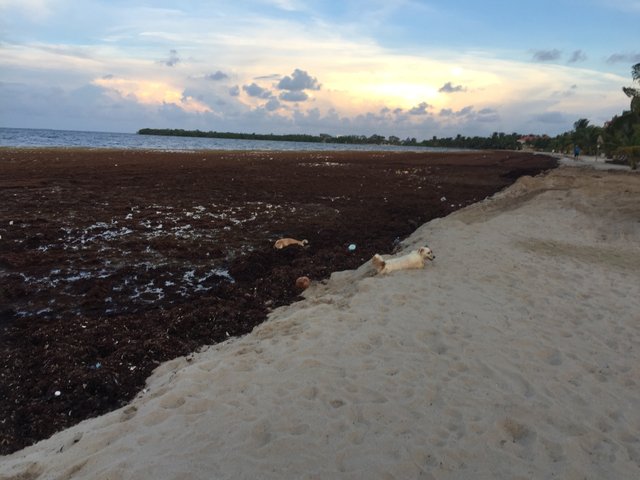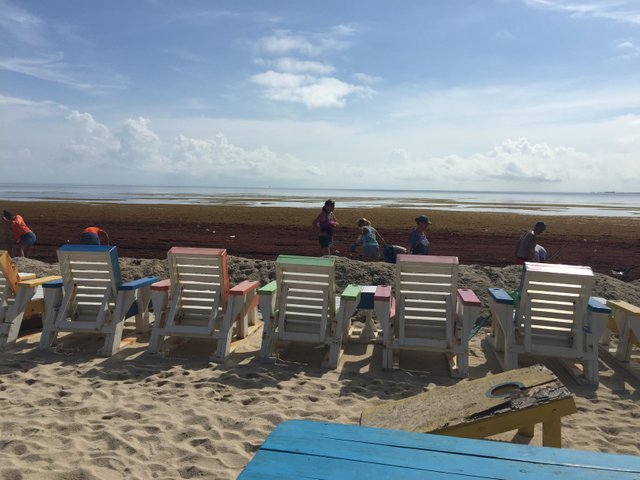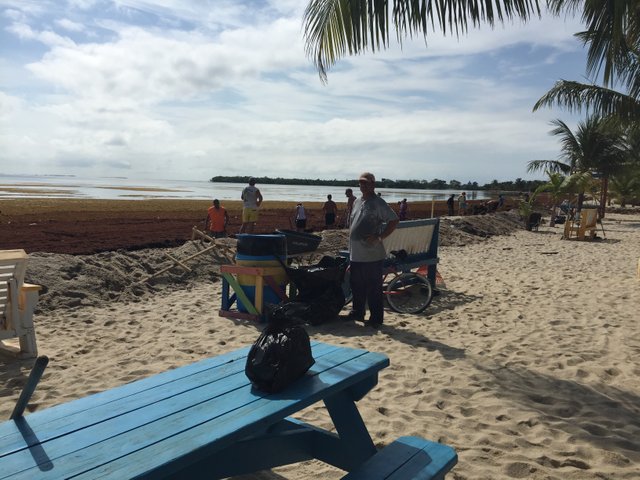Sargassum Crisis in Caribbean and clean-up in Belize
Greetings Steemians
We have now been in Belize a month.
We are witnessing the influx of large amounts of sargassum seaweed which is clogging up the coastlines of a number of nations in the Caribbean Sea and the Gulf of Mexico.
What is Sargassum?

When its fresh, it looks like the picture above. The bladders in it keep it afloat on the sea. After it lands on shore it clogs up, dries up and dies, killing marine organisms trapped beneath it by starving them of oxygen.
Sargassum was named by the Portuguese sailors who found it in the Sargasso Sea after the wooly rock rose (Halimium lasianthum) that grew in their water wells at home and that was called sargaço in Portuguese...Species of this genus of algae may grow to a length of several metres. They are generally brown or dark green in color and consist of a holdfast, a stipe, and a frond. Oogonia and antheridia occur in conceptacles embedded in receptacles on special branches. Some species have berrylike gas-filled bladders that help the fronds float to promote photosynthesis. Many have a rough sticky texture that, along with a robust but flexible body, helps it withstand strong water currents. [Source: Wikipedia - https://en.wikipedia.org/wiki/Sargassum]
When larger volumes of sargassum deposit on coastlines, marine organisms, including hatching sea turtles and fish under the decaying seaweed become starved of oxygen in the water and they usually die.
The algae washes ashore, piles up on beaches, and decays, often causing a foul odor, releasing fumes of sulphur compounds that rust metals, that can turn taps black in shore houses, damages modern conveniences, and causes respiratory problems, particularly for asthmatics. 52 patients were recorded by a single doctor in Guadeloupe with Sargassum-related symptoms. Insurance problems arise for tourist operators and homeowners, where the household and business losses do not fall into previous insurance categories. Wildlife also suffers; for example, sea turtle hatchlings that die on their way to the open water. The affected countries and territories are discussing causes of the outbreak, potential solutions, and the negative effects on tourism. [Source: Wikipedia -https://en.wikipedia.org/wiki/Sargassum]
At last night's town meeting (yep we have those here) - one of the residents was showing me her silver jewellery had turned black because of all the sulphur in the air.
The influx of sargassum in its present volumes first became apparent in the Caribbean in 2011 and 2015 and its arrival in these larger volumes is linked to rising sea temperatures because of climate change as well as agriculture run-off from fertilisers which makes the algae bloom.
Countries like Belize survive because of the tourism dollar. If the multi-million tourism industry is killed by this ongoing problem, then the local economies would quickly wither and die with villages becoming ghost towns.
I personally don't think this is likely although the upcoming tourist season will most definitely suffer if this latest infestation isn't managed appropriately. That the entire Caribbean coastline is as severely affected will protect the local economy. That and the fact that many expats here have ongoing property investments and businesses that they will not be abandoning any time soon. Some have raised their children here who have gone on to become pivotal members of the community. The hardware guy here has been living in Belize for 25 years, his daughter studied Pharmacy at Belize City and is the local pharmacist here and has children with a Belizean national. They love Belize and they will fight hard to keep the community and environment viable.
I joined the local community here in Placencia to participate in a clean-up using buckets, pitchforks and shovels with about 80 of the townsfolk this morning. After three hours of back-breaking work it looked as though we had hardly made a dent in it. This seaweed is dense, heavy and foul smelling. After a few hours of work your skin and eyes are stinging from the sulphur emanating from the sargassum. The local community also brought in some backhoes to help with the clean up but the Belizean Government needs to urgently find funds for the necessary equipment to address the problem effectively. Manpower (or woman-power in my case) is simply not enough to fix the problem.
Clean-up efforts underway
This year this recent outbreak is affecting all Caribbean nations along the Gulf of Mexico.
The Mexican Government is spending about $9.1 million and hiring 4,600 temporary workers to clean up the seaweed mounds and also testing whether they can collect the sargassum at sea before it reaches the shorelines and clogs up the tourist beaches.
Hopefully the local communities and town councils and the Government of Belize will do their best to remove the seaweed. Otherwise this tourist season we may be seeing this kind of review on Trip Advisor in upcoming months:

Let's hope this problem is solved sooner, rather than later. Meanwhile I can still smell the sulphur from the rotting seaweed just a mile away from my home. Tourism also has a detrimental impact on the local ecosystems - but that is material for another article.




Very interesting, I kind of figured there where different kinds of seaweed on a basic level but now I know. It’s great that the government is taking this serious and that there is a community effort to try to help the nature and clean up.
Great article I can see you put time in. I want ya o encourage you too keep up the good work..
Thanks dude - how is life in Sweden going? I have been following your posts as well.
The world is really huge.
Everyone has their own problems. Here you have a problem with algae, and I've never seen them.
But the Land is our common home. And we have to watch him together.
Good work and post and photos!